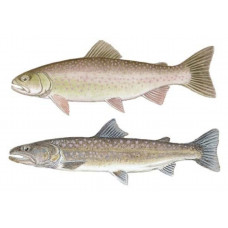Latin name
Salvelinus malma, Salvelinus confluentus
Other names
Bull charr, western brook trout, Rocky Mountain trout, red spotted salmontrout, red spotted charr.
Identification
These two char species, as well as Arctic char, are difficult to distinguish by appearance alone, even for specialists. In general, Dolly Varden and bull trout can be distinguished by size and habitat. Dolly Varden are usually a coastal species, while the larger bull trout inhabit inland waters, namely large cold rivers and lakes draining highland areas. Although both can grow large, they rarely do. Dolly Varden tend to be smaller and have a more rounded body shape. Bull trout have larger, flattened heads and more pronounced hooks in their lower jaws. The colour of both varies with habitat and terrain, but their bodies tend to be olive green, with the back darker than the light sides. Cream or pale yellow patches (slightly smaller than the pupil of the eye) cover the back and red or orange patches cover the flanks. The pectoral, ventral and anal fins have white or creamy edges. The male in full autumn spawning dress has a dark olive back, sometimes bordering on black. The orange-red belly, bright spots and fluorescent white fin edges rival the spectacular colours of autumn. Dolly Varden are silvery and the spots can be very faint.
Distribution
Dolly Varden are found from the Sea of Japan, across the Kuril Islands to Russia's Kamchatka Peninsula, across the Aleutian Islands and around Alaska and the Yukon Territory to the Northwest Territory. They are also found in the northwestern United States. In North America, they are particularly common in Alaska and parts of British Columbia. Bull trout are endemic to the Pacific Northwest and inhabit most of the major watersheds on both sides of the continental divide. It appears to prefer large, cold rivers and lakes that drain high elevations and is often found at the bottom of deep basins. It has been recorded in northern California, Oregon, Washington, northern Nevada, Idaho, western Montana, Alberta and British Columbia.
Habitat
Bull trout and Dolly Varden prefer the deep pools of cold rivers, lakes and reservoirs. Streams with abundant cover (cut banks, root clumps and other woody debris) and clean gravel and cobble banks provide the best habitat. Their preferred summer water temperature is usually below 55°F, but they can tolerate temperatures below 40°F. Autumn spawning usually begins when water temperatures drop to 40°F. Cold, clear water is essential for successful breeding.
Size
Dolly Vardens usually weigh between 1 and 3 pounds, while freshwater specimens rarely exceed 8 pounds. The world record for all tackle is a fish from Alaska weighing 20lb 14oz. Bull trout grow larger than sea trout, although the typical fish weighs between 2 and 5 pounds. The world all-tackle record is a 32-pound, 401⁄2-inch bull trout caught in Lake Pend Oreille, Idaho, in 1949.
Life history and Behavior
Bull trout and Dolly Varden have complex but similar life histories. Anadromous and migratory populations often travel long distances in the summer and autumn to spawn, migrating to small headwater streams where they incubate. Sexually mature individuals with these characteristics are typically 4 to 7 years old and 18 to 22 inches long when they first spawn, although they may be older in some populations. Spawning begins in late August, peaks in September and October, and ends in November. Fish in a given stream spawn for a short time, 2 weeks or less, leaving red patches on the clean gravel. Almost immediately after spawning, the adults begin to make their way back to the main rivers, lakes or reservoirs to overwinter. Some of these fish stay put. Others move to salt water in the spring, apparently not wading far.
Food and feeding habits
Bull trout and Dolly Varden are opportunistic feeders. They feed on aquatic insects, shrimps, snails, leeches, fish eggs and fish.
Reproduction
No information
| Classification | |
| Phylum | Chordata |
| Class | Actinopterygii |
| Squad | Salmoniformes |
| Family | Salmonidae |
| Genus | Salvelinus |
| Species | S. malma, S. confluentus |
| Features | |
| Conservation status | Vulnerable |
| Habitat | Pelagic |
| Life span, years | No information |
| Maximum body weight, kg | 14.5 |
| Maximum length, cm | 103 |
| Sailing speed, m/s | No information |
| Threat to people | Edible |
| Way of eating | Predator |
Dolly Varden, Bull Trout
Tags: Dolly Varden, Bull Trout


